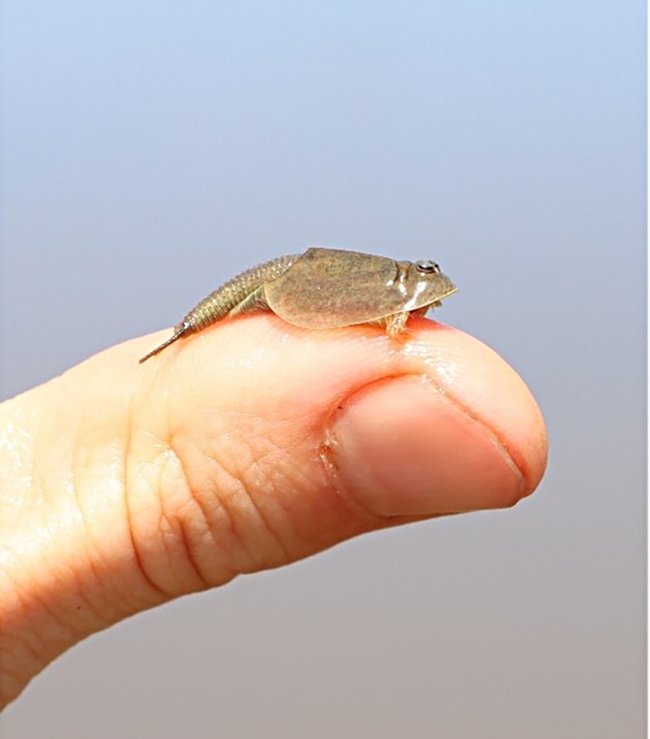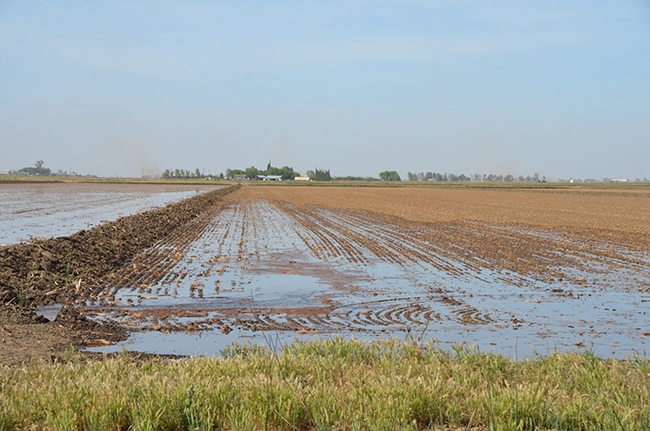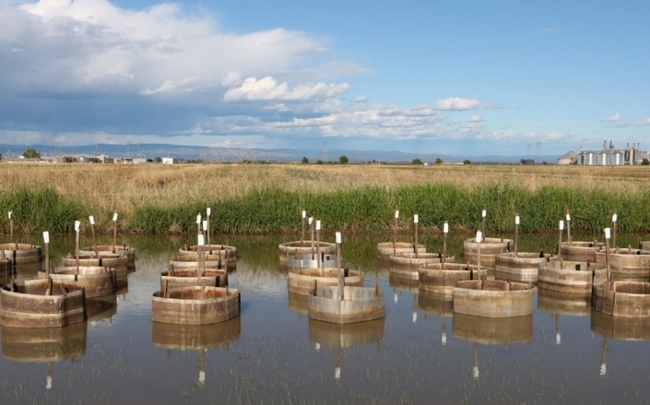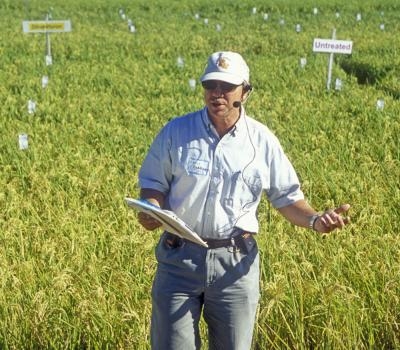- Author: Kathy Keatley Garvey

Agricultural entomologist and Cooperative Extension specialist Ian Grettenberger of the UC Davis Department of Entomology and Nematology and his colleagues propose alternative management.
Grettenberger's poster, “Past Pyrethroids: Alternative Management Approaches for Tadpole Shrimp in Rice,” presented at Entomological Society of America meeting (Oct. 31-Nov. 3) in Denver, offers non-pesticide alternatives, including the use of mosquitofish.
Collaborative research with UCCE Butte County director and Rice Farming Systems Advisor Luis Espino and UC Davis staff research associate Kevin Goding, indicates that mosquitofish proved able to suppress shrimp populations.
“Tadpole shrimp (Triops longicaudatus) are an early-season pest in California rice,” Grettenberger explained in his abstract. “Soon after flooding, eggs hatch and growing shrimp are soon large enough to damage germinating rice seedlings. Currently, pyrethroid insecticides are heavily relied upon for management, as they are in many cropping systems, because of their efficacy and low cost. However, contamination of surface waters is a concern, as is insecticide resistance.”
"We evaluated alternative management strategies that could be used to manage tadpole shrimp,” he wrote. “We tested a number of materials using small metal ring plots and natural shrimp populations. This included several timings of applications to mimic an early, more proactive application along with a later, rescue application, as well as reduced rates of a number of insecticides.”

Deep Look Video. Tadpole shrimp recently made the national news in two ways, Grettenberger said. First, they made news with the sudden appearance of tadpole shrimp following monsoon rains this summer in an ancient ceremonial ball court at the Wupatki National Monument in northern Arizona (https://www.livescience.com/dinosaur-shrimp-emerge-arizona). In October, KQED's Deep Look released a new video, “Tadpole Shrimp Are Coming For Your Rice," the work of lead producer and cinematographer Josh Cassidy and other members of the Deep Look crew. (See https://youtu.be/T2xnXaX7r3g.) Grettenberger assisted with the project, providing tadpole shrimp and taking some of the video clips used in the five-minute video.
“Much of his shooting was in my garage,” the UC Davis entomologist said, “so I get to see just how much effort and care goes into producing these videos. They end up pretty short, but that doesn't mean it is simple to get all the pieces together.”
“This tadpole shrimp is coming for your rice,” the narrator said. “Hungry hordes of them find their way into the ice fields of California's Central Valley and go to town munching on the young seedlings. But where did they come from, with the ocean so far away? A couple of weeks ago, this was just a dry dusty field. Turns out they were here all along.”
Deep Look referred to them as “time travelers,” as the eggs of shrimp tadpoles can be viable for decades and hatch when the rice growers flood their fields. "At the very least, they have survived as eggs since last season," Grettenberger noted.
The pests are neither tadpoles or shrimp but are fresh-water crustaceans descended from the ocean. “They look like tiny horseshoe crabs,” Grettenberger told Deep Look. “It's obvious when rice fields have lots of tadpole shrimp in them, because they stir up the mud making the water look a bit like chocolate milk. There will also be shrimp zooming around, many upside down at the surface, popping up for a few seconds before disappearing back into the murkiness."
Adult tadpole shrimp cannot survive when the soil dries out. But Grettenberger said their eggs have a rugged outer layer called a “chorion” that protects the eggs from desiccation.
“They've been living this way for hundreds of millions of years-- since before the dinosaurs-- waiting out droughts, changing climates, even global catastrophes,” KQED relates in the video. “In a world where the future is unpredictable, tadpole shrimp are the ultimate survivors.”
Grettenberger, who joined the UC Davis Department of Entomology faculty in January, 2019, focuses his research on field and vegetable crops; integrated pest management; applied insect ecology; and biological control of pests.
Additional Information:
- Resource on tadpole shrimp, UC Statewide Integrated Pest Management Program (co-authors, the late Larry Godfrey, UC Davis Department of Entomology and Nematology; Luis Espino, UC Cooperative Extension; and Sharon Lawler, UC Davis Department of Entomology and Nematology
- "Effect of Rice Winter Cultural Management Practices on the Size of the Hatching Population of Triops longicaudatus (Notostraca:Triopsidae) in California Rice Fields" (Co-authors Larry Godfrey,



- Author: Kathy Keatley Garvey

Godfrey, who has addressed Rice Field Day for 25 years, will discuss how the California rice industry's use of insecticides is threatened by two major factors: the development of insecticide resistance and regulatory actions.
Materials registered for California rice, Godfrey said, include pyrethroids (Mustang®, Warrior®),neonicotinoid (Belay®), insect growth regulator (Dimilin®), and carbamate (Sevin®). One additional product is in the registration pipeline, a ryanodine receptor modulators (Coragen®).
“However, as shown in the 2015 season when armyworms reached unprecedented levels--the highest of the last 25 years-- the insecticide choices were limited and all options had some deficiencies in terms of efficacy on armyworms,” Godfrey said. “Fortunately, the California Rice Commission was able to get an emergency exemption (Section 18) for Intrepid® to help with this situation. All these registered insecticides need to be managed carefully so they are available and effective in future years and for future generations.”
Joanna Bloese, a student in the Godfrey lab, will present a poster, "Evaluating the Effects of Chemical and Cultural Management Practices on the Population Dynamics of Tadpole Shrimp (Triops longicaudatus) in California Rice." (Research by J. B. Bloese, L. Espino, K. Goding, L. D. Godfrey). Ongoing research is focused on developing pest management methods in rice to reduce the need for insecticide use while still producing a profitable crop. Kevin Goding, staff research associate, also will be participating in Rice Field Day.
The purpose of the Rice Field Day, sponsored by the California Cooperative Rice Research Foundation (CCRRF) and the University of California, is to give rice growers and others an opportunity to observe and discuss research in progress at the Rice Experiment Station (RES).
The program will begin at 8:30 a.m. with a general session that serves as the annual membership meeting. Posters and demonstrations will be displayed during registration until after lunch. Field tours of research will emphasize progress on rice variety improvement, and disease, insect pest, and weed control. The program will conclude at noon with a lunch that includes rice.
More information is available on the CRRF website at http://www.crrf.org/


